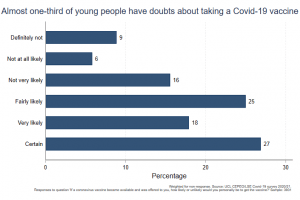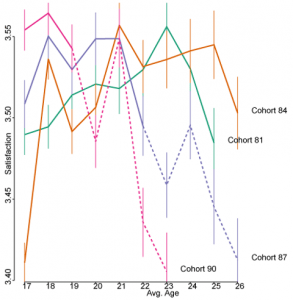The challenges of COVID-19 for young people need a new cohort study: introducing COSMO
By IOE Editor, on 23 April 2021
Jake Anders and Carl Cullinane
The COVID-19 pandemic and its impact is a generation-defining challenge. One of its most concerning aspects, particularly in the long term, is the already profound effect it has had on young people’s lives. Disruption to their development, wellbeing and education could have substantial, long-lasting effects on later life chances, particularly for those from lower-income homes. Evidence is already showing disadvantaged pupils lagging 5 months behind their peers. This poses a unique challenge for educational policy and practice, with the scale of the disruption requiring solutions to match that scale.
In order to address these impacts, it is vital that we fully understand these effects, and in particular, the disproportionate burden falling on those from certain groups, including those from lower socio-economic backgrounds and minority ethnic groups. This needs high-quality data. Recovering from the effects of the past 12 months will be a long–term project, and to reflect this we need research of similar ambition.
The COVID Social Mobility and Opportunity Study (COSMO for short), launched today, seeks to play this role, harnessing the power of longitudinal research to capture the experiences of a cohort of young people for whom the pandemic has had an acute impact, and its effects on their educational and career trajectories.
This country has a grand tradition of cohort studies, including the pioneering 1958 National Child Development Study and the 1970 British Cohort Study. Such studies are a key tool in understanding life trajectories and the complex factors that shape them. And they are particularly vital when it comes to measuring the impact of events that are likely to last through someone’s life course. The existing longitudinal studies, including those run by our colleagues in the UCL Centre for Longitudinal Studies, have played a huge role in understanding the impacts of the pandemic on society in the last year.
But there is a key gap in the current portfolio of cohort studies: and that is the generation of young people at the sharp end of their school education, who would have taken GCSEs this summer, and within a matter of months will be moving onto new pathways at sixth form, further education, traineeships and apprenticeships. The impacts on this group are likely to be profound and long-lasting, and understanding the complex elements that have aggravated or mitigated these impacts is crucial.
A variety of studies have already collected some such data, providing emerging evidence of inequalities in pupils’ outcomes and experiences of remote schooling. This has highlighted alarming challenges for pupils’ learning and wellbeing. However, to develop a full understanding we require the combination of rich, representative, survey data on topics such as learning loss experiences, wellbeing, and aspirations, linked with administrative data on educational outcomes, and concurrent interventions. We also need to follow up those young people over the next few years as they pass through key stages of education and their early career, to understand what has happened next, ideally long into their working lives.
Such evidence will be key in shaping policies that can help to alleviate the long–term impacts on young people. Which groups have suffered most and how, how long will these impacts persist, and how can we reduce their effect. These will be fundamental questions for national policymakers, education providers, employers and third sector organisations in the coming years, both in the UK and internationally.
That’s why we’re extremely excited to be launching COSMO with funding from UK Research and Innovation (UKRI)’s Ideas to Address COVID-19 response fund. Our study will deliver exactly that data over the coming years, helping to inform future policy interventions that will be required, given that the huge effects of the pandemic are only just beginning. As the British Academy pointed out on the anniversary of the first COVID lockdown – this is not going to go away quickly.
Beginning this autumn, the study will recruit a representative sample of 12,000 current Year 11 pupils across England, with sample boosts for disadvantaged and ethnic minority groups plus targeting of other hard-to-reach groups. Young person, parent, and school questionnaires – enhanced with administrative data from DfE– will collect rich data on young people’s experiences of education and wellbeing during the past challenging 12 months, along with information on their transitions into post-16 pathways via this summer’s unusual GCSE assessment process.
The study is a collaboration between the UCL Centre for Education Policy & Equalising Opportunities (CEPEO), the UCL Centre for Longitudinal Studies (CLS) and the Sutton Trust. The study will harness CEPEO’s cutting-edge research focused on equalising opportunities across the life course, seeking to improve education policy and wider practices to achieve this goal. The Sutton Trust also brings 25 years of experience using research to inform the public and achieve policy change in the area of social mobility.
COSMO will also be part of the family of cohort studies housed in the UCL Centre for Longitudinal Studies, whose expertise in life course research is world-renowned. We are also working closely with Kantar Public, who will lead on delivering the fieldwork for this large study, alongside NatCen Social Research. More broadly still, all our work will be co-produced with project stakeholders including the Department for Education and the Office for Students. We are also working with partners in Scotland and Wales to maximise comparability across the nations.
We are excited for COSMO to make a big contribution both to the landscape of educational research and to the post-pandemic policy environment, and we are delighted to be getting to work delivering on this promise over the coming years.
 Close
Close








